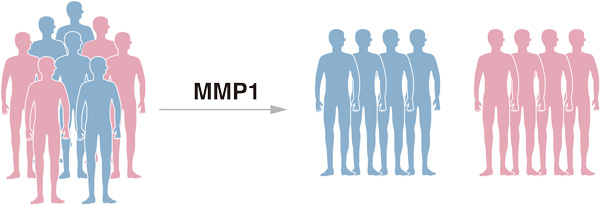
Research Activities
Research Activities
Publications
July 19, 2016
A new model for kidney disease

Doctors are unable to differentiate which AKPKD patients have a high risk for aneurysms. A new iPS cell model indicates MMP1 could be used to identify these patients
Cystic fibrosis and sickle cell anemia are well known monogenic diseases - diseases caused by a single defective gene, but the most common is one much harder to run off the tongue, autosomal dominant polycystic kidney disease (ADPKD). ADPKD is caused by a single mutation in one of two genes, and estimates have millions of people suffering from the disease. ADPKD is marked by the formation of cysts in the kidneys that in many cases leads to severe renal failure that require dialysis or transplantation. Because it is genetic, the disease is believed to initiate before birth, but symptoms generally do not reveal themselves until well into adulthood.
Although ADPKD primarily affects the kidney, its pathology will spread to other organs. "Intracranial aneurysms [ICA] are a serious concern in ADPKD patients," says CiRA Professor Kenji Osafune, but not all patients will develop ICA. To understand which patients are at risk, the Osafune lab prepared iPS cells from skin cells of several ADPKD patients, some with ICA and others without, to search for molecular markers indicating higher risk. The iPS cells were then differentiated into different cell types of the vasculature and observed.
"We searched for genes that had different expression levels in the two groups," said Osafune. "And we found MMP1." The team then retroactively looked at the expression levels of MMP1 in hundreds of ADPKD patients, and after some statistical analysis found that MMP1 expression could indeed be used as a risk factor for ICA complication.
While ADPKD is a familial disease, not all patients sharing the same mutation have the same risk for ICA. To Osafune, this might indicate other genes could also contribute to the ICA in ADPKD. "We are investigating other markers for ICA using our model," he said.
Paper Details
- Journal: Scientific Reports
- Title: Identification of MMP1 as a novel risk factor for intracranial aneurysms in ADPKD using iPSC models
- Authors: Tomognaga Ameku1, Daisuke Taura2, Masakatsu Sone2, Tomohiro Numata3,4, Masahiro Nakamura1, Fumihiko Shiota1,5, Taro Toyoda1, Satoshi Matsui1, Toshikazu Araoka1, Tetsuhiko Yasuno1, Shin-Ichi Mae1, Hatasu Kobayashi6, Naoya Kondo7, Fumiyo Kitaoka1, Naoki Amano1, Sayaka Arai1, Tomoko Ichisaka1, Norio Matsuura6, Sumiko Inoue6, Takuya Yamamoto1,8, Kazutoshi Takahashi1, Isao Asaka1, Yasuhiro Yamada1,8, Yoshifumi Ubara9, Eri Muso7, Atsushi Fukutatsu5, Akira Watanabe1,8, Yasunori Sato10, tatsutoshi Nakahata1, Yasuo Mori3,4, Akio Koizumi6, Kazuwa Nakao2, Shinya Yamanaka1 and Kenji Osafune1
- Author Affiliations:
- Center for iPS Cell Research and Application (CiRA), Kyoto University, Kyoto, Japan
- Department of Medicine and Clinical Science, Kyoto University, Kyoto, Japan
- Department of Synthetic Chemistry and Biological Chemistry, Graduate School of Engineering, Kyoto University, Kyoto, Japan
- Department of Technology and Ecology, Hall of Global Environmental Studies, Graduate School of Engineering, Kyoto University, Kyoto, Japan
- Department of Artificial Kidneys, Graduate School of Medicine, Graduate School of Engineering, Kyoto University, Kyoto, Japan
- Department of Environmental and Health Sciences, School of Public Health, Graduate School of Engineering, Kyoto University, Kyoto, Japan
- Division of Nephrology, Kitano Hospital, Tazuke Kofukai Medical Research Institute, Osaka, Japan
- Institute for Integrated Cell-Material Sciences (iCeMS), Graduate School of Engineering, Kyoto University, Kyoto, Japan
- Nephrology Center and Okinaka Memorial Institute for Medical Research, Toranomon Hosptial, Tokyo, Japan
- Clinical Research Center, Chiba University of Medicine, Chiba, Japan






















